Discount Tyres has the best tyre maintenance tips online. Upkeep costs on cars can be kept to a minimum with proper tyre care. We all know running a car is expensive, so follow these tyre care tips and avoid unexpected bills.
Look after your tyres. Ideally a driver gets 20,000 miles out of front tyres on a front-wheel drive car and double that for the rear tyres.
Tyres have to meet a lot of different and sometimes conflicting requirements.
Long-life tyres are manufactured from harder compounds, but these make more noise.
Softer compound tyres generate less noise but will wear out more quickly.
1.The law states that there should be a minimum tread depth of 1.6mm. It must be measured across the central 3/4 of the tyre and all the way round it too.
The first part of the law says there must be a minimum of 1.6mm of tread. This means that the depth of the grooves MUST BE NOT LESS THAN 1.6mm.
(See image 1)
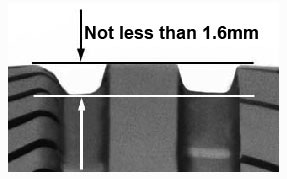
2. The second part of the law says that the 1.6mm measurement must be across the central 3/4 of the tyre.
This means that at any point across the main part of the tyre, the tread depth MUST BE NOT LESS THAN 1.6mm.
(See image 2)
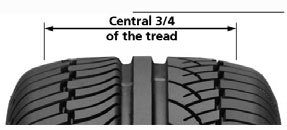
3. The third part of the law says that the 1.6mm measurement must be all the way round the tyre.
This means that there MUST BE NOT LESS THAN 1.6mm of tread all the way round the tyre.
(See image 3)
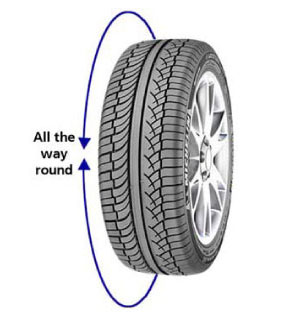
It’s all about safety. Independent tests commissioned by RoSPA have shown that your stopping distance increases greatly when the depth of your tyres’ tread gets down to the legal minimum.
The legal minimum is just that: an absolute minimum. Your stopping distance in the wet will start to increase dramatically when your tyres’ tread depth gets below 3mm. Of course, this depends on what surface you are driving on and the temperature as well.
RoSPA recommends that for maximum safety you change your tyres when the depth gets to 3mm.
We recommend that you use newer tyres for the rear set, for extra safety in unforeseen or difficult situations (emergency braking, tight bends etc.) particularly on wet surfaces.
Numerous tests have shown that it is easier to control the front wheels than those at the rear.
Front tyres generally wear quicker than those fitted at the rear, particularly on front-wheel-drive cars, which are currently in the majority.

That's why we advise you to reduce the risks you take by fitting new or less worn tyres at the rear of the vehicle for:
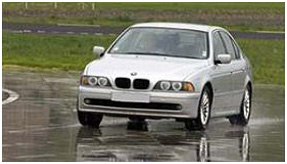
Ever wondered what the markings on the side of a tyre mean?
205/55 R 16 91V
This information describes the size and characteristics of the tyre:
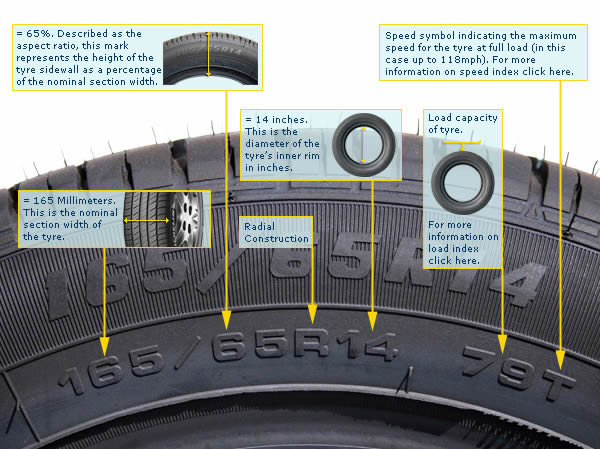
The correct pressure is important both for safety and for a long tyre life.
Your tyres must be checked when they are cold (by cold we mean the ambient outside temperature where the tyre is to be used).
Tyre pressures must be checked regularly, about once every two weeks.
A drop in pressure can be caused by:
Why check your tyre pressures?
You will...

☆☆☆☆☆ Went into discounts today! As a single women l find garages quite intimidating and also a rip off. From Passed experience has always been one tyre becomes four. Well not here. This place is honest, trustworthy and professional. I was offered coffee on arival and offered different options and also the guy took me to my car to show me too! Even on leaving the guys said if ture pressures become low or if theres anything lm unsure of pop in anytime! These guys are amazing! Me and my children will be safe and l feel comfortable enough to go back whenever theres a problem!!!! I would highly recommend this place great customer service and price!!!!!!!!!!!! Keep up the good work guys!!!!!!!!!!!!!
☆☆☆☆☆ Called then up 8:30am with a puncture repair request, after I managed to hit a kerb, swerving to miss another driver. They had it fixed and I was back on the road by 9:30am. Awesome work!
☆☆☆☆☆ These guys havent won awards for nothing, i felt totaly reasured and was given a few options to keep me safe, had the best wheel alignment ever and was even given a hot drink and tv to watch while i waited. the guys are brilliant and like friends. almost feel like going back just to say hello. i look forward to my next puncture
☆☆☆☆☆ Nothing is never too much for these guys! Always get fantastic service
☆☆☆☆☆
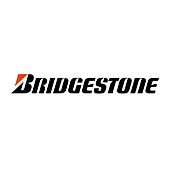


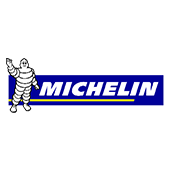



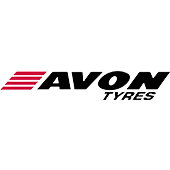


Site by Big Marketing Ltd.